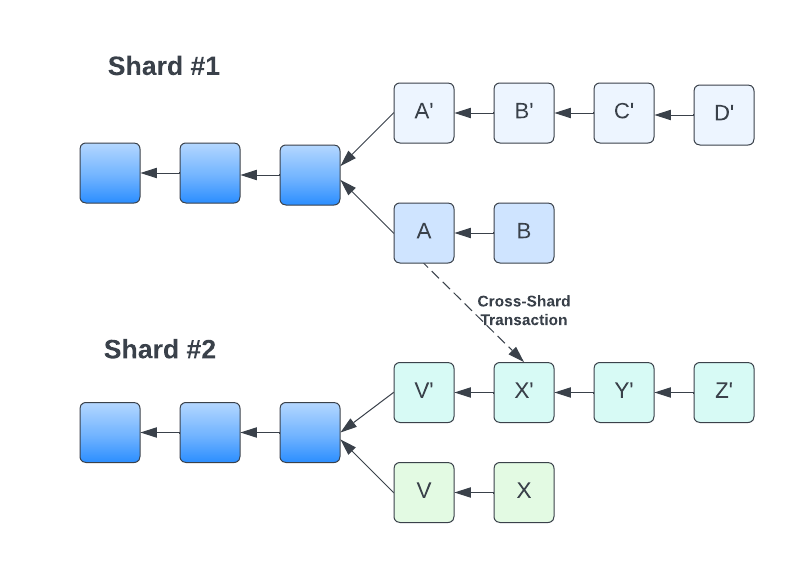Sharding: A Panacea for Blockchain Scalability Challenges?#
Innovation & Ideation
Key Insights
Sharding is a promising scaling technique for blockchains, dividing the network into smaller partitions called shards to process transactions in parallel, thus increasing throughput.
Sharding approaches in blockchain systems vary, with solutions like Ethereum 2.0 using multiple shard chains coordinated by a beacon chain, and others, such as Near Protocol’s Nightshade, opting for processing data chunks in a single blockchain with different validator sets.
Sharding implementation faces challenges in security, cross-shard communication, and data availability. These require solutions like random validator assignment, transaction receipts, and erasure coding.
While sharding offers potential scalability improvements, layer 2 solutions like ZK-Rollups and Optimistic Rollups remain the preferred short-term scaling methods until sharding proves its ability to handle high transaction volumes.
As the adoption of blockchain technology increases, scalability remains the central challenge and a major obstacle for blockchain to be adopted by mainstream industries. Bitcoin can only process 7 transactions per second (TPS), while the Ethereum blockchain can only process 15 TPS. Although after the Merge of Ethereum 1.0 into Ethereum 2.0, the TPS of Ethereum 2.0 is expected to reach 100,000 TPS, gas fees remain a major issue. Ethereum has been relying on ZK-rollups to scale the network, but rollups are only a short-term solution because of interoperability issues with other blockchains since they are mainly Ethereum-focussed. Therefore, the blockchain community is actively looking for a solution to the scalability problem.
What is Sharding?#
Sharding, originally a database design principle, is now being considered a promising solution to overcome the scalability challenges of blockchain systems. This scaling technique divides the blockchain network into smaller partitions called shards, each responsible for processing a subset of transactions. This allows the blockchain to process more transactions in parallel, thereby increasing the throughput of the system.
There are 2 common techniques blockchains implement to improve throughput:
Delegate all the computation to a small set of powerful nodes; (e.g., Algorand, Solana)
Each node in the network only does a subset of the total work (Sharding). Ethereum, Near, Hedera use this technique.
Note
Sharding in Blockchains vs Traditional Databases
The sharding techniques used in traditional databases cannot be directly applied to blockchains because of the following reasons:
Blockchains rely on Byzantine Fault Tolerance (BFT) consensus protocols which are a scalability bottleneck.
Distributed databases depend on highly available transaction coordinators for atomicity and isolation assurance; however, blockchain coordinators could exhibit malicious behaviour.
In a distributed database, any node can belong to any shard, but a blockchain must assign nodes to shards in a secure manner to ensure that no shard can be compromised by the attacker.
Different Sharding Approaches#
Huang et al. [HPZ+22] proposed a new cross-shard blockchain protocol called BrokerChain that aims to address the issue of hot shards and reduce the number of cross-shard transactions. They showed this protocol outperforms other state-of-the-art sharding methods in terms of transaction throughput, confirmation latency and queue size of the transaction pool. Tennakoon et al. [TG22] propose a blockchain sharding protocol with dynamic sharding where smart contract invocations stored in blocks reconfigure the sharding. This protocol is effective because it improves the efficiency of the blockchain, preventing resource wasting by closing the shards that are not processing as many transactions or are idle. There have been a few proposed sharded blockchains such as Elastico [LNZ+16], OmniLedger [KKJG+18] and RapidChain [ZMR18]. Nonetheless, such systems are predominantly constrained to cryptocurrency use cases in open (or permissionless) environments. Due to their reliance on the unspent transaction output (UTXO) model—a simplistic data structure—, these methods lack generalisability for applications beyond Bitcoin [DDL+19]. So we will focus on more general-purpose blockchains such as Ethereum and Near Blockchain.

Fig. 24 Sharding in Ethereum vs Near Blockchain#
Conclusion#
Sharding is the most promising solution to overcome the scalability challenges of blockchain systems. However, although Ethereum and Near have made significant progress in implementing sharding, it is still not time-tested and it remains to be seen whether these blockchains will be able to bear a load of transactions volume when scenarios such as DeFi boom or NFT craze happen again. Until then, layer 2 solutions such as ZK-Rollups and Optimistic Rollups will continue to be the preferred scaling solutions for blockchain systems.
References#
- DDL+19
Hung Dang, Tien Tuan Anh Dinh, Dumitrel Loghin, Ee-Chien Chang, Qian Lin, and Beng Chin Ooi. Towards scaling blockchain systems via sharding. In Proceedings of the 2019 international conference on management of data, 123–140. 2019.
- HHS22
Abdelatif Hafid, Abdelhakim Senhaji Hafid, and Mustapha Samih. A tractable probabilistic approach to analyze sybil attacks in sharding-based blockchain protocols. IEEE Transactions on Emerging Topics in Computing, 2022.
- Hed20(1,2)
Hedera. Hedera hashgraph whitepaper. Hedera, 2020. URL: https://hedera.com/hh_whitepaper_v2.1-20200815.pdf.
- HPZ+22
Huawei Huang, Xiaowen Peng, Jianzhou Zhan, Shenyang Zhang, Yue Lin, Zibin Zheng, and Song Guo. Brokerchain: a cross-shard blockchain protocol for account/balance-based state sharding. In IEEE INFOCOM 2022-IEEE Conference on Computer Communications, 1968–1977. IEEE, 2022.
- KKJG+18
Eleftherios Kokoris-Kogias, Philipp Jovanovic, Linus Gasser, Nicolas Gailly, Ewa Syta, and Bryan Ford. Omniledger: a secure, scale-out, decentralized ledger via sharding. In 2018 IEEE Symposium on Security and Privacy (SP), 583–598. IEEE, 2018.
- KTTI22
Alexander Kudzin, Kentaroh Toyoda, Satoshi Takayama, and Atsushi Ishigame. Scaling ethereum 2.0 s cross-shard transactions with refined data structures. Cryptography, 6(4):57, 2022.
- LNZ+16
Loi Luu, Viswesh Narayanan, Chaodong Zheng, Kunal Baweja, Seth Gilbert, and Prateek Saxena. A secure sharding protocol for open blockchains. In Proceedings of the 2016 ACM SIGSAC conference on computer and communications security, 17–30. 2016.
- Nea20a
Near. Near nightshade whitepaper. Near, 2020. URL: https://near.org/papers/nightshade/.
- Nea20b
Near. Near runtime spec. Near, 2020. URL: https://nomicon.io/RuntimeSpec/Receipts.
- TG22
Deepal Tennakoon and Vincent Gramoli. Dynamic blockchain sharding. In 5th International Symposium on Foundations and Applications of Blockchain 2022 (FAB 2022). Schloss Dagstuhl-Leibniz-Zentrum für Informatik, 2022.
- ZMR18
Mahdi Zamani, Mahnush Movahedi, and Mariana Raykova. Rapidchain: scaling blockchain via full sharding. In Proceedings of the 2018 ACM SIGSAC conference on computer and communications security, 931–948. 2018.

